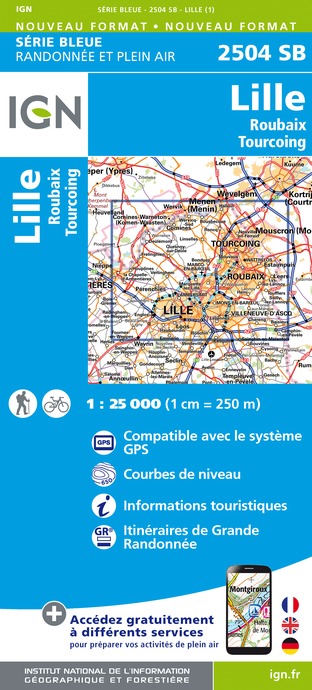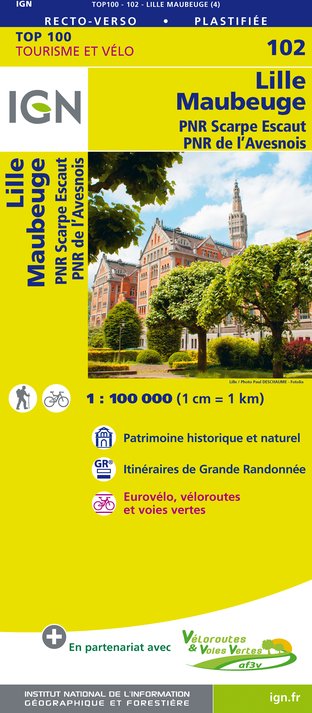Alert
Alerts
Type of practice
Cycling
Presentation
Map
Points of interest
Cirkwi brief's
Ratings and reviews
See around
Tourcoing: artistic and architectural eclecticism from Boulevard Gambetta to Avenue de la Marne

Credit : E.Ducoulombier
The Cirkwi brief
Discover Art Deco Splendors on Tourcoing's Scenic Route
Embark on a captivating journey through the vibrant streets of Tourcoing, where the architectural and artistic delights of Boulevard Gambetta, Boulevard Descat, and Avenue de la Marne await. From the enchanting Art Deco designs that capture the imagination to the intricate details of Indian palaces and creatively repurposed factories in the image sector, this route promises a rich tapestry of visual marvels. The transformation of entertainment complexes into pulsing hubs of artistic production and the historical whispers of bunkers echoing Verlaine's verses add layers of intrigue. Curated by the Métropole Européenne de Lille, this itinerary marvelously blends heritage with modern creativity, ensuring a journey as enlightening as it is beautiful.
Tech Specs: Tourcoing Route Overview
Spanning 9.5 km with altitudes ranging from 30 to 54 meters, this scenic cycle route through Tourcoing offers a modest elevation gain of approximately 16-17 meters, making it accessible for riders of varying abilities. Perfect for leisurely bike rides, it provides an unparalleled opportunity to explore the architectural marvels and artistic legacies embedded in the heart of the city. The carefully planned course ensures an immersive experience into the region's rich tapestry of cultural and architectural history, designed with both the avid enthusiast and casual observer in mind.
Seasonal Tips for Tourcoing Explorers
No matter the season, Tourcoing's route through its architectural wonders offers distinct experiences. For summer visitors, early mornings or late afternoons are ideal to avoid the midday heat. Spring and autumn promise cooler temperatures and vibrant natural colors, enhancing the visual journey. Winter explorers should dress warmly, ensuring layers that can be adjusted throughout the day. Safety-wise, always wear a helmet, carry water, and keep your mobile charged. Respect local traffic laws, and for an enhanced experience, consider guided tours available through local tourism offices which delve deeper into the stories behind the facades.
The Heart of Northern France's Heritage
Tourcoing, nestled within the Hauts-de-France region, stands as a testament to the resilience and creativity of the northern French spirit. Its streets and buildings narrate stories of industrial prowess, artistic innovation, and a community's endurance through times of change. The city's commitment to preserving and repurposing its architectural gems, from Art Deco masterpieces to industrial landmarks transformed into cultural havens, reflects a deep respect for its past. Tourcoing, by blending its rich history with contemporary culture, serves as a vibrant emblem of the region's ongoing journey of renewal and rediscovery.
Weather Insights for Your Tourcoing Visit
The climate in Tourcoing, typical of Northern France, features mild summers and cool winters, with occasional rain throughout the year. The best time for a visit, especially for cycling through the picturesque routes, would be late spring to early autumn, from May to September. During these months, you'll enjoy the most pleasant weather, with ample sunshine and moderate temperatures ranging from 15°C to 25°C. Always check the weather forecast before setting out, as the region can experience sudden changes, ensuring you're prepared for an enjoyable exploration of Tourcoing's architectural jewels.
Embark on a captivating journey through the vibrant streets of Tourcoing, where the architectural and artistic delights of Boulevard Gambetta, Boulevard Descat, and Avenue de la Marne await. From the enchanting Art Deco designs that capture the imagination to the intricate details of Indian palaces and creatively repurposed factories in the image sector, this route promises a rich tapestry of visual marvels. The transformation of entertainment complexes into pulsing hubs of artistic production and the historical whispers of bunkers echoing Verlaine's verses add layers of intrigue. Curated by the Métropole Européenne de Lille, this itinerary marvelously blends heritage with modern creativity, ensuring a journey as enlightening as it is beautiful.
Tech Specs: Tourcoing Route Overview
Spanning 9.5 km with altitudes ranging from 30 to 54 meters, this scenic cycle route through Tourcoing offers a modest elevation gain of approximately 16-17 meters, making it accessible for riders of varying abilities. Perfect for leisurely bike rides, it provides an unparalleled opportunity to explore the architectural marvels and artistic legacies embedded in the heart of the city. The carefully planned course ensures an immersive experience into the region's rich tapestry of cultural and architectural history, designed with both the avid enthusiast and casual observer in mind.
Seasonal Tips for Tourcoing Explorers
No matter the season, Tourcoing's route through its architectural wonders offers distinct experiences. For summer visitors, early mornings or late afternoons are ideal to avoid the midday heat. Spring and autumn promise cooler temperatures and vibrant natural colors, enhancing the visual journey. Winter explorers should dress warmly, ensuring layers that can be adjusted throughout the day. Safety-wise, always wear a helmet, carry water, and keep your mobile charged. Respect local traffic laws, and for an enhanced experience, consider guided tours available through local tourism offices which delve deeper into the stories behind the facades.
The Heart of Northern France's Heritage
Tourcoing, nestled within the Hauts-de-France region, stands as a testament to the resilience and creativity of the northern French spirit. Its streets and buildings narrate stories of industrial prowess, artistic innovation, and a community's endurance through times of change. The city's commitment to preserving and repurposing its architectural gems, from Art Deco masterpieces to industrial landmarks transformed into cultural havens, reflects a deep respect for its past. Tourcoing, by blending its rich history with contemporary culture, serves as a vibrant emblem of the region's ongoing journey of renewal and rediscovery.
Weather Insights for Your Tourcoing Visit
The climate in Tourcoing, typical of Northern France, features mild summers and cool winters, with occasional rain throughout the year. The best time for a visit, especially for cycling through the picturesque routes, would be late spring to early autumn, from May to September. During these months, you'll enjoy the most pleasant weather, with ample sunshine and moderate temperatures ranging from 15°C to 25°C. Always check the weather forecast before setting out, as the region can experience sudden changes, ensuring you're prepared for an enjoyable exploration of Tourcoing's architectural jewels.
Automatically generated.
IGN cards

2504SB - LILLE ROUBAIX TOURCOING
Editor : IGN
Collection : TOP 25 ET SÉRIE BLEUE
Scale : 1:25 000
13.90€

102 LILLE MAUBEUGE PNR SCARPE ESCAUT PNR DE L'AVESNOIS
Editor : IGN
Collection : TOP 100
Scale : 1:100 000
8.40€

D59-62 NORD PAS-DE-CALAIS
Editor : IGN
Collection : CARTES DÉPARTEMENTALES IGN
Scale : 1:150 000
5.90€

NR01 HAUTS-DE-FRANCE
Editor : IGN
Collection : CARTES RÉGIONALES IGN
Scale : 1:250 000
6.80€

EUROPE
Editor : IGN
Collection : DÉCOUVERTE DES PAYS DU MONDE IGN
Scale : 1:2 500 000
7.00€

PAYS-BAS BELGIQUE LUXEMBOURG
Editor : IGN
Collection : DÉCOUVERTE DES PAYS DU MONDE IGN
Scale : 1:300 000
7.00€
Technical Information
Cycling
Difficulty
Not specified
Dist.
9.6 km
Type of practice
Cycling
Show more
Altimetric profile
Starting point
Lat : 50.7174Lng : 3.15842
Points of interest
Data author
Ratings and reviews
To see around















